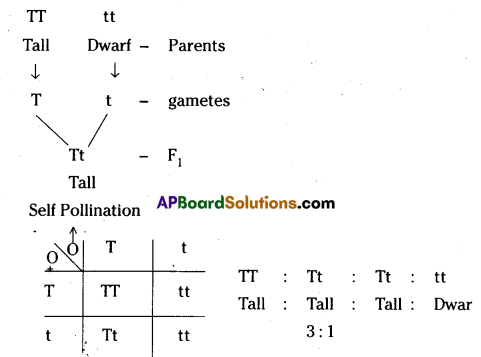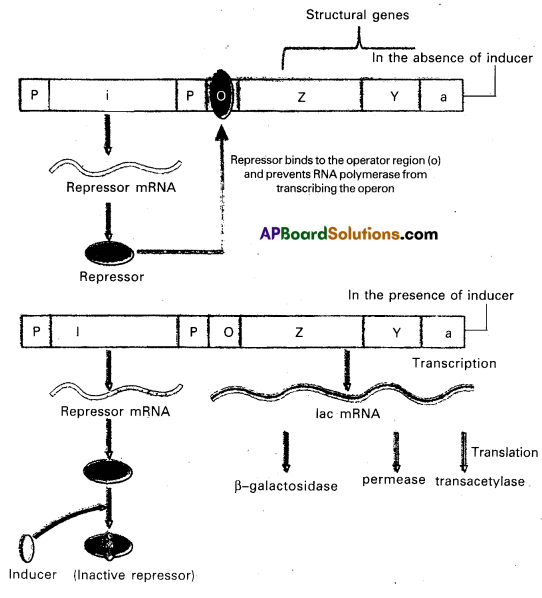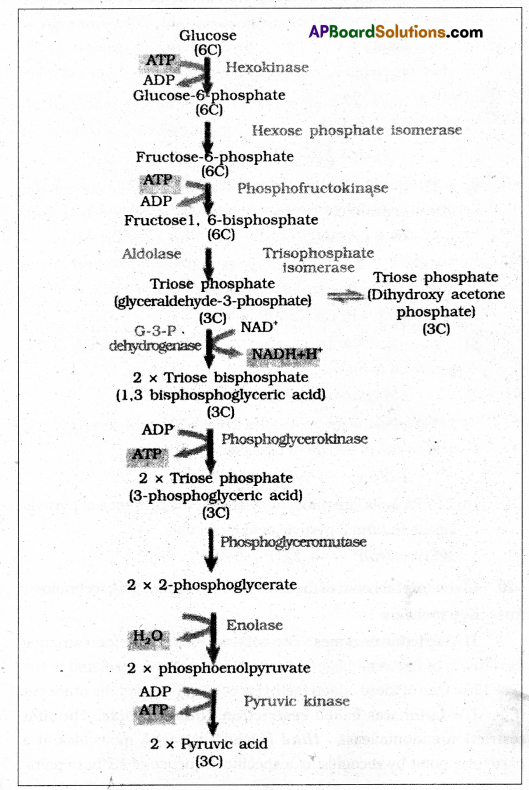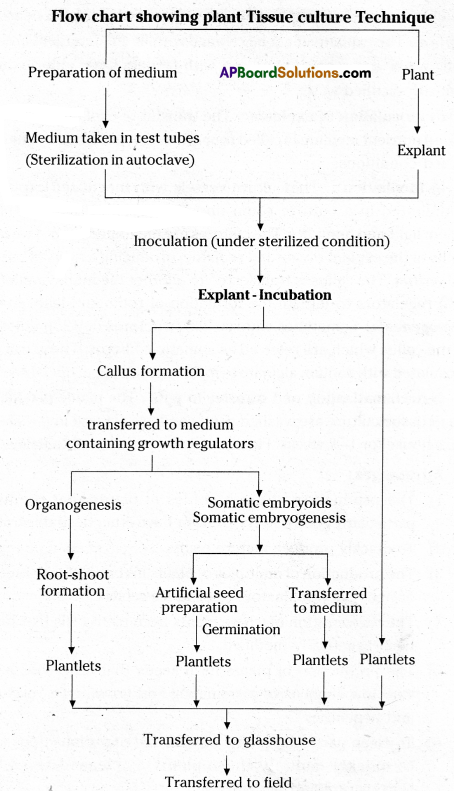Thoroughly analyzing AP Inter 2nd Year Botany Model Papers and AP Inter 2nd Year Botany Question Paper March 2015 helps students identify their strengths and weaknesses.
AP Inter 2nd Year Botany Question Paper March 2015
Time: 3 Hours
Max. Marks: 60
Note: Read the following instructions carefully.
- Answer all questions of Section A. Answer any six questions out of eight in Section B and answer any two questions in Section C.
- In Section-A, questions from Sr. Nos. 1 to 10 are of “Very Short Answer Type”. Each question carries two marks. Every answer may be limited to five lines. Answer all these questions at one place in the same order.
- In Section B, questions from Sr. Nos. lIto 18 are of “Short Answer Type”. Each question carries four marks. Every answer may be limited to 20 lines.
- In Section-C, questions from Sr. Nos. 19 to 21 are of “Long Answer Type”. Each question carries eight marks. Every answer may be limited to 60 lines.
- Draw labelled diagrams wherever necessary for questions in Section-B and C.
Section – A
10 x 2 = 20
Note: Answer all questions. Each answer may be limited to 5 lines.
Question 1.
Explain the role of the pink colour pigment in the root nodule of legume plants. What is it called?
Answer:
Oxygen scavenger or It removes oxygen from the vicinity of nitrogenase enzyme. It ¡s Ieg-haemoglobin.
Question 2.
Define the terms quiescence and dormancy.
Answer:
Quiescence is the condition of seed when it is unable to germinate only because of favourable external conditions normally required for Growth are not present. Dormancy is the condition of a send when it fails to germinate only because of Internal conditions, even though external conditions are suitable.
Question 3.
Differentiate virulent phages and temperate phages.
Answer:
| Virulent phages | Temperate phages |
| 1. Viruses that attack the bacterium cause lysis of the cells. | 1. Phage DNA that enters into the bacterial cell gets integrated into the bacterial DNA, becomes part of it and remains Latent. |
| 2. They show lytlc cycle. Ex: T-even phages. | 2. They show lysogenic cycle. Ex: Lambda phage. |
Question 4.
What is the genetic nature (Genotype) of wrinkled phenotype of pea seeds.
Answer:
rr
![]()
Question 5.
In a typical DNA molecule, the proportional of thymine is 20% of the N-bases. Find out the percentages of other N-bases.
Answer:
Adenine 20%
Guanine = 30%
Cytosine = 30%
Question 6.
Define stop codon. Write the codons.
Answer:
The codons which do not code for any amino acids are called stop codons. They are UAA, UAG, UGA.
Question 7.
How does one visualize DNA on Agar gel?
Answer:
The DNA fragments can be visualised only after staining the DNA with Ethidium bromide followed by exposure to Uy radiation.
Question 8.
What is GEAC and what are its objectives?
Answer:
Genetic Engineering approval committee. It makes decision regarding the validity of GM research and the safety of Introducing GM organisms for public services.
Question 9.
Give two examples of fungi used in SCP production.
Answer:
- Candida utilis (Torula yeast)
- Saccharomyces cerevisiae (Baker’s yeast)
- Chaetomium Cellulolyticum.
Question 10.
Name a microbe used for statin production. How do statins lower blood cholesterol levels?
Answer:
Monascus perpureas. It acts by competitively inhibiting the enzyme responsible for the synthesis of cholesterol.
Section-B
6 x 4 = 24
Note: Answer any six questions. Each answer may be limited to 20 lines.
Question 11.
How does ascent of sap occur in tall trees?
Answer:
Upward movement of water through xylem against gravitational force ¡s called ascent of sap. The transition-driven ascent of sap depends on three principles. They are:
- Cohesion: Mutual attraction between water molecules.
- Adhesion: Attraction of water molecules with lignified walls of xylem.
- Transpiration pull: Driving force for upward movement of water.
As water evaporates through the stomata, since the thin film of water over the cell is continuous, results in pulling of water, molecules by molecule into the leaf from the xylem. Also because of lower concentration of water vapour in the atmosphere, water diffuses out into the surrounding air. This creates transpiration pull. The forces generated by the transpiration can create pressure sufficient to lift a continuous column of water over 130 metres high.
![]()
Question 12.
Write briefly about enzyme inhibitors.
Answer:
The chemicals that can shut off enzyme activity are called Inhibitors. They are of 3 types.
1. Competitive inhibitors: Substances which closely resemble the substrate molecules and inhibits the activity of the enzyme are called competitive inhibitors.
Eg: Inhibition of succinic dehydrogenase by malonate which closely resembles the substrate succinate.
2. Non-competitive inhibitors: The inhibitors which have no structural similarity with the substrate and hind to an enzyme at locations other than the active sites, so that the globular structure of the enzyme is changed are called noncompetitive inhibitors.
Eg: Metal ions of Copper, Mercury.
3. Feedback inhibitors: The end product of a chain of enzyme-catalysed reactions Inhibit the enzyme of the first reactions as a part of homoeostatic control of metabolism are called feedback inhibitors.
Eg: During respiration (Glycolysis) accumulation of Glucose-6 Phosphate occurs, it inhibits the Hexokinase.
Question 13.
Write any eight differences between C3 and C4 plants.
Answer:
| C3 Plants | C4 plants |
| 1. Leaves do not show Kranz’s anatomy. | 1. Leaves show Krenz anatomy. |
| 2. Chloroplasts are similar and do not show dimorphism. | 2. Chloroplast dimorphism is seen. |
| 3. The primary acceptor of CO2 = RUBP. | 3. The primary acceptor of CO2 is PEPA. |
| 4. The first stable product is = PGA(3c). | 4. The first stable product is = OAA(4c). |
| 5. Photo respiration is very high. | 5. Photo respiration is not detectable. |
| 6. The optimum temperature is 15-25°C. | 6. The optimum temperature is 30-45°C |
| 7. They utilise 18 ATP molecules to synthesise 1 glucose. | 7. They utilise 30 ATP molecules to synthesize 1 glucose. |
| 8. Photosynthetic yield is low. | 8. Photosynthetic yield is very high. |
| 9. They utilise water less efficiently. | 9. They utilise water more efficiently. |
Question 14.
What are the physiological processes that are regulated by ethylene in plants?
Answer:
- Ethylene promotes the ripening of fruits.
- Ethylene promotes the senescence and abscission of leaves and abscission of Leaves and flowers.
- Ethylene breaks seed and bud dormancy and initiates germination in peanut seeds and sprouting of potato tubers.
- Ethylene promotes rapid internode/petiole elongation in deep-water rice plants.
- it also promotes root growth and root hair formation, thus helping plants to Increase their absorption surface.
- Ethylene is used to initiate flowering (mango) and for synchronising fruit set in pineapples.
- it promotes female flowers in cucumbers, thereby increasing the yield.
Question 15.
What are the nutritional groups of bacteria based on their source of energy & carbon?
Answer:
1. Photoautotrophs: They are photosynthetic i.e., they capture light energy and transform into chemical energy and obtain carbon from atmospheric CO2.
Eg: Chiorobium, Chromatium.
2. Chemoautotrophs: They derive energy from the oxidation of Inorganic substances and carbon from atmospheric CO2.
Eg: Nltrosomonas, Nitrobacter, Beggiaotoa and Methanogens.
3. Photoheterotrophs: They capture light energy and carbon from other organic sources. Eg: Rhodospirillum and Rodospseudomonas.
4. Chemoheterotropbs: They derive both carbon and energy from organic compounds.
Eg: Xanthomonas, Salmonella.
![]()
Question 16.
Explain the Law of Dominance using a Monohybrid cross.
Answer:
Characters are controlled by discrete units called factors. They occur In pairs. In a dissimilar pair of factors pertaining to a character one number of the pair dominates the other The law of dominance Is used to explain the expression of only one of the parental characters In a monohybrid cross In the F1 and the expression of both in the F2 generations. It also explains the proportion of 3:1 obtained at the F2 generation.

Question 17.
Draw the schematic/diagrammatic presentation of the Lac operon.
Answer:

Question 18.
Describe a brief account on Bt. Cotton.
Answer:
Some strains of Bacillus thuringiens is produce proteins that kill certain insects such as lepidopterans (tobacco budworm, armyworm), coleopterans (beetles) and dipterans (flies, mosquitoes). Bacillus thuringiens is forms protein Crystals which contain a toxic insecticidal protein. The gene responsible for the production of this toxic protein is introduced genetically into the cotton seeds protect the plants from Boliworm, a Major pest of cotton. Use of Bt. Cotton has led to 3-27% increase in cotton yield in countries where it is grown.
The toxin is coded by a gene named cry. The proteins encoded by the genes cry lAc and cry hAb control the cotton bollworms and cry IIAb controls corn borer.
Section – C
2 x 8 = 16
Question 19.
Give an account of Glycolysis. Where does it occur? What are the end products? Trace the fate of these products in both aerobic and anaerobic respiration.
Answer:
Glucose is broken down into 2 molecular of pyruvic acid is called Glycolysis. It was given by Gustav Embden, Otto Mayerhof and J.Parnas so called EMP Pathway. It occurs ¡n the cytoplasm of the cell and takes place in all living organisms. In this, 4 ATP are formed of which two are utilized and 2 NADPH+H+’ are formed. A the end of glycolysis, 2 PA. 2 ATP and 2 NADPH+H+’ are formed as end products. The ATP and NADPH+H+ are utilised for fixation of CO2.
Glycolysis occurs In cytoplasm, pyruvic acid, 2ATP, 2 NADPH+, H are the end products. In aerobic respiration, pyruvic acid, 2 NADPH+H+ are completely oxidised through TCA cycle, ETS pathway and produce 36 ATP molecules. In anaerobic respiration, pyruvic acid is partially oxidised results in the formation of ethyl alcohol and CO2.
Reactions:
1. Glucose is phosphorylated in the presence of Kinase to form glucose -6-phosphate.
Glucose + ATP → Glucose-6-phosphate + ADP
2. G-6F Is isomerised to Fructose-6-phosphate in the presence of Isomerase
G-6F →F6P
3. Fructose 6 phosphate ¡s phosphorylated in the presence of hexokinase to form Fructose 1, 6 Biphosphate.
66P + ATP → F1,6 BiP + ADP

4) F 1, 6 BiP undergoes cleavage in the presence of Aldolase to form 1 Dihydroxy acetone phosphate and 1 Glyceraldehyde 3 phosphate
F1,6BiP → 1 DHAP+1G3P
5) DHAP does not undergo oxidation in further reactions, so gets isomerised to another G3P in the presence of Isomerase.
1DHAP →1G3P
6) 2 molecules of G3P undergoes dehydrogenation in the presence of dehydrogenase to form 2 molecules of 1,3 DPGA.
2G3P + 2NAD+ → 2-1,3 DPGA + 2NADH + H+
7) 2 mol. of 1, 3 DPGA undergoes dephosphorylation in the presence of phosphor Glycerokinase to form 2 mol. of 3 PGA 2-1,3DPGA+2ADP → 2-3PGA+2ATP
8) 2 mol. of 3PGA are converted into 2 mol. of 2PGA in the presence of mutage.
2-3PGA → 2-2 PGA
9) 2-PGA looses water molecules to form 2-phosphoenol pyruvic acid in the presence of Enolase.
2-2PGA → 2-PEPA + H2O
10) 2 PEPA mols, are phosphorylated in the presence of pyruvic kinase to form 2 pyruvlc acid molecules.
2PEPA + 2ADP → 2ATP + 2PA
![]()
Question 20.
Give a brief account of the tools of recombinant DNA technology.
Answer:
Key tools are:
1. Restriction enzymes: Two enzymes responsible for restricting the growth of Bacteriophage in Escherichia cou were isolated in the year 1963. One of these added methyl groups to DNA and the other cut DNA. The latter was called restriction endonuclease. The first restriction endonuclease – Hind II which cut DNA molecules at a particular point by recognising a specific sequence of six base pairs, called recognition sequence for Hind II. Today, more than 900 restriction enzymes were isolated from over 200 strains of Bacteria, each of which recognises a different recognition sequence.
E CORI is a restriction enzyme in which, the first Letter comes from the genus (Esclierichia), and the second two letters from the species of the Prokaryotic cell cou), the letter R is derived from the name of strain. Roman numbers indicate the order in which the enzymes were isolated from that strain of Bacteria. Restriction enzymes belong to a larger class of enzymes called nucleases.
They are of two types.
a) Exoucleases which remove nucleotides from the ends of the DNA.
b) Endonucleases which make cuts at specific location within the DNA.
Most restriction enzymes cut the two strands of DNA double helix at different locations. Such a cleavage is known as staggered cut. E CoRI recognises 5’ GAAIT3’ sites on the DNA and cuts It between G and A results in the formation of sticky ends or cohesive end pieces. This stickyness of the ends facilitates the action of enzyme DNA ligase.
2. Cloning vectors: The DNA used as a carrier for transferring a fragment of foreign DNA into a suitable host is called vector. Vectors used for multiplying the foreign DNA sequences are called cloning vectors. Commonly used cloning vectors are plasmids bacterlo phages, cosmids. Plasmids are extrachromosomal circular DNA molecules present in almost all bacterial species. They are Inheritable and carry few genes are easy to isolate and reintroduce into the bacterium (Host).
Features required to facilitate cloning into a vector:
- Origin of replication : (ori) This is a sequence from where replication starts and any piece of DNA when linked to this sequence can be made to replicate within host cells. It is also responsible for controlling the copy number of the linked DNA.
- Selectable marker: In addition to ‘ori’, the vector requires a selectable marker, which helps in identifying and eliminating non-transformants and selectively permitting the growth of the any transformants normally, the genes encoding resistance to antibiotics such as ampicillin, chloramphenicol, tetracycline or kanamycin etc., are useful selectable markers for E.coli.
- Cloning sites: In order to link the alien DNA, the vector needs to have very few, preferably single recognition sites for the restriction enzymes.
- Molecular weight: The cloning vector should have low molecular weight.
- Vectors for cloning genes in plants and animals: The tumour-inducing (Ti) plasmid of Agrobacterium tumefacient has now been modified into a cloning vector such that it is no more pathogenic to plants. Similarly, retroviruses have also been disarmed and are now used to deliver desirable genes into animal cells.
3. Competent Host: The bacterial cells must be made competent to take up DIV A with a divalent cation, such as calcium which increases the efficiency with which DNA enters the bacterium through pores in the cell wall.
Question 21.
Describe the tissue culture technique and what are the advantages of tissue culture over conventional methods of plant breeding in crop improvement programmes.
Answer:
Tissue culture Technique: It involves
a) Preparation of Nutrient medium: The nutrient medium is a mixture of various essential nutrients, amino acids, vitamins and carbohydrates. These are mixed ¡n distilled water and pH is adjusted to 5.6 to 6.0. Growth regulators like auxins and cytokinins are added to the medium. The nutrient medium is poured in glass vessels and closed tightly with cotton plugs before sterilizing them in an autoclave.
b) Sterilisation: The nutrient medium is rich in nutrients and therefore attracts the growth of microorganisms & The culture medium is autoclaved for 15 mins, at 120°c or 15 pounds of pressure to make aseptic.
c) Preparation of explant: Any living part of plant can be used as explant. The explants must be cleaned with liquid detergent and in running water and surface sterilised with sodium hypochlorite and rinsed with distilled water.
d) Inoculation of explants: The transfer of explants onto the sterilized nutrient medium is called inoculation. It is carried out under sterilized conditions.
e) Incubation: The culture vessels with inoculated explants are incubated in a culture room under controlled temperature, optimum light and humidity. The cultures are incubated for 3-4 weeks, the cells of the explant divide and redivide, producing a mass of tissue called callus.
The callus is transferred to another medium containing growth regulators to initiate the formation of roots and leafy shoot (organogenesis). Sometimes embryo-like structures develop directly from the callus which are referred as somatic embryos. These can be encapsulated with sodium alginate to form synthetic or artificial seeds.
f) Acciamatization and transfer to pots: The plants produced through tissue culture are washed gently and are planted in pots kept in glass house for 1-2 weeks. Finally, they are transferred to field.
![]()
Advantages:
- The production of exact copies of plants that produce particularly good flowers, fruits or have other desirable traits.
- To quickly produce mature plants.
- The production of multiples of plants in the absence of seeds or necessary pollinators to produce seeds.
- The regeneration of whole plants from plant cells that have been genetically modified.
- The production of plants from seeds that otherwise have very low chances of germinating and growing i.e., orchids and nepenthes.
- To clean particular plants of viral and other infections and to quickly multiply these plants as cleaned stock for Horticulture and Agriculture.
